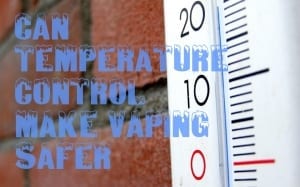 How Safe is Vaping?
How Safe is Vaping?
Since e-cigarettes first became available in Western society, millions of smokers have flocked to the new technology. Many people vape in the hopes that they will reduce their disease risk without having to quit smoking forever, a daunting prospect that can be nearly impossible to maintain.
It is verifiable that vaping is 99% safer than cigarette smoking. Even so, there are ways that it can be made even safer. One way is to reduce the incidence of carbonyl production in vapor.
What’s a carbonyl?
A carbonyl is a type of chemical that can form when propylene glycol (PG) and vegetable glycerin (VG), the main two solvents in e-liquid, degrade. Two of the most common carbonyl byproducts of this degradation are formaldehyde and acetaldehyde, both of which are hazardous at high levels.
A study was published back in May of this year in which various liquids were vaporized in an e-cigarette at different voltages using a smoking machine. They used ‘the most popular device available on the Polish market as of January 2013,’ which consisted of a top coil 2.4 ohm clearomizer with a 900 mah variable voltage battery.
They tested the device at 3.2, 4.0, and 4.8 volts using a variety of e-liquids ranging from 100% PG to 100% VG. They found that the levels of formaldehyde and acetaldehyde detected in vapor were fairly low at 3.2 and 4.0 volts, yet rose dramatically at 4.8 volts, often to nearly the same levels as found in cigarette smoke.
Since they did not test any voltage between 4.0 and 4.8, it is impossible to determine the exact voltage at which the carbonyl production will increase. However, determining this voltage may not be necessary – it is unlikely that the higher voltage itself is causing this.
So what’s causing it then??
Many of us began vaping using top coil clearomizers such as the one featured in this study. Most will remember the first time they cranked the voltage up to 4.8 – it led to a nasty, burning, gross taste, which was immediately followed by turning the voltage back down and remembering to never do that again.
This is known as a dry hit, or dry puff. It is when most of the liquid has vaporized, so the wick dries out and starts to burn. When the voltage is cranked that high on a top coil clearomizer, the liquid can vaporize too fast – the wick cannot pull liquid up to the atomizer quickly enough, and it dries out.
When the atomizer dries out, it is able to heat to a higher temperature. It can reach a temperature at which whatever liquid is left on it begins to degrade in a combustion reaction. The byproducts of this combustion can include carbonyls such as formaldehyde and acetaldehyde.
That sounds nasty! Can it be prevented??
Yes, this can definitely be prevented.
The key difference between vaporization and combustion is temperature. All we have to do is heat the coil to a high enough temperature for the liquid to begin to evaporate, or vaporize. If we raise that temperature by a few hundred more degrees, it will begin to combust and produce carbonyls.
Essentially, we need to keep the liquid within a safe temperature range. Luckily for us, this is fairly easy to do.
Many of you have rebuilt coils. You have noticed, then, that if you heat the bare coil it will turn bright red fairly quickly. However, if you wick the coil, soak it in e-liquid, and then heat it, it will not turn red.
Keeping the coil next to a soaked wick keeps it cool. As long as your wick is wet, you will only vaporize the liquid. Once it dries out, however, it may heat to a higher temperature and burn, and this can produce some carbonyls. Fortunately for us, this only happens occasionally, and thus is unlikely to lead to ill health effects.
Technology to the Rescue!
It is great that we can avoid dry burning most of the time, but what if we can prevent it altogether?
Last week Evolv announced the release of their new DNA 40 chip for digital mods. It has a new feature never seen before in vaping: it limits the temperature so you can never vape too hot.
Brandon from Evolv said that their company fast tracked the release of this new chip due to safety concerns. He said that when temperature control is enabled, your atomizer will never be able to go above a certain temperature.
This feature requires the use of nickel wire to measure the temperature. This may seem concerning at first, but keep in mind that when controlling the power, the voltage output of the device is automatically adjusted to match the resistance of the atomizer. Thus, the exact resistance of your build matters a lot less.
Brandon also noted that with this feature, you will be able to vape your wick completely dry without it ever burning. This is because the temperature will never be allowed to rise that high.
For more information on the new Evolv chip, as well as a link to Phil Busardo’s interview with Brandon from Evolv, click here.
More Research is on the Way
In addition to this technological advancement, Dr. Konstantinos Farsalinos, a noted researcher of vapor products, announced a new crowdfunding campaign for his next research project. In this study, he and his team will attempt to determine at exactly what temperature carbonyl compounds are produced in vapor, among other things. The following is a breakdown of his research goals:
- Measure temperatures of evaporation under various puffing conditions (different wattage levels and puff duration).
- Determining puffing patterns which would result in less thermal load but maintain level of pleasure and vapor production.
- Determine the emission of potentially toxic chemicals in relation to the thermal load.
- Determine the development of dry-puff conditions, and how the temperature load is altered in dry-puff conditions.
- Evaluate all of the above utilizing numerous resistance levels and wicking materials.
Dr. Farsalinos says that the more money he can raise for his research, the more he can expand it to include different vaping conditions. In addition to laboratory testing, he plans to observe real vapers and collect information from them in his study, rather than rely solely on puffing machines. He also has plans to investigate sub ohm vaping.
Overall the goal of this study is to provide the most realistic and relevant information on vaping and production of potentially hazardous substances so that we are better informed on how to keep ourselves as safe as possible. He has stated explicitly that this study is for us, not for regulators.
The results of this study, when completed, will give us a very clear picture of what temperature and under what conditions we can vape safely or if temperature control plays a role in safe vaping.
A Safer Vape
As I said earlier, vaping is safer than smoking. The production of carbonyls in vapor falls in that 1% of lingering hazards. However, it is not hard to vape more safely.
Above all, keep your wicks wet. This will keep your coil cool and your vapor safe. If you do experience a dry hit now and then, do not fret – you are still highly unlikely to get sick from a small amount of short term exposure to carbonyls. If you have any doubt about this, compare that one dry puff to the number of drags in all the cigarettes you used to smoke in a day, and remember that each of those are more dangerous.
In the end, there is still not much to worry about. As long as it keeps you from smoking, keep on vaping on.

Interesting article and quite informative but I have a concern about the dna 40 chip that no one has addressed.
That issue is in the requirement of using Ni200 wire and vaping at 0.15 ohms.
At that resistance the stress on the battery is quite severe and ever since the dna 40 came out, it seems like this has become a thing of the past as well.
But in reality, is it?
I will stick with my nichrome 80, I’m mot even messing around with temp control,nickel,titanium can’t do that at this points